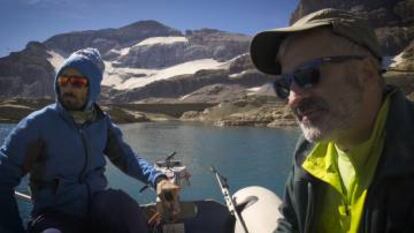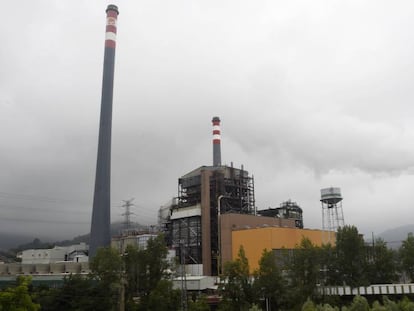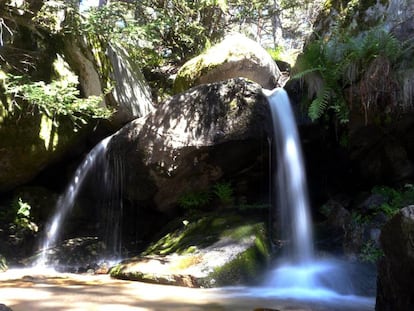The chilling extinction of SpainˇŻs last glacier
The frozen expanse of Monte Perdido is receding at an alarming rate and could disappear within three decades
Close to the summit of Vignemale, the highest mountain in the Pyrenees, there are several mysterious holes in the rock that have been blasted open by dynamite, providing a door to an age so different to ours that the accompanying story hardly seems true.
In 1882, Count Henry Russell had rented the entire mountain for the symbolic amount of one franc a year. He then ordered the construction of seven caves from where he could watch the sun set over the Ossoue glacier, SpainˇŻs third biggest. Once the work was done, he proceeded to throw parties for his friends there at an altitude of over 3,000 meters.
The openings of the refuges were more or less level with the ice in order to make entry seamless, but anyone trying to get in today is confronted with the challenge of climbing a rock wall several meters high. ItˇŻs one of the quainter examples of a global phenomenon: the recession of the glaciers that is closely linked to climate change.
The Pyrenees are warming at twice the rate of the planet as a whole
Geologist Ignacio L¨®pez-Moreno
From the Andes to the Alps, the Himalayas to the Antarctic, the overwhelming majority of the EarthˇŻs glaciers are melting at a rate unprecedented ¨C at least since records were first made. But the thaw is particularly intense in the Pyrenees where it is causing more of a wholesale disappearance than a mere retreat. Thirty-three of the 52 glaciers that were here in 1850 have gone, most of them after 1980. From the 3,335-meter high summit of Monte Perdido, you can look down on the remains of the most recent casualty ¨C a beautiful turquoise lake that was, until the late 1990s, a small glacier.
Ignacio L¨®pez-Moreno is like a surgeon whose patient dies without him being able to do anything to save him. The son of a computer scientist and a housewife, this geographer from Zaragoza is the only child of seven to have gone into science. Since 2011, his team from the Pyrenean Institute of Ecology (IPE) ¨C which is the center for the Spanish National Research Council (CSIC) ¨C has been analyzing the Monte Perdido glacier. Monte Perdido is the biggest glacier left in the Pyrenees together with the Maladeta, and it is without doubt the most closely analyzed. No other mountain chain in Spain can boast glaciers anymore. These are the last.
ˇ°These glaciers, the most southern in Europe, are in a very precarious state. Everything indicates that they will be the first to disappear,ˇ± says L¨®pez-Moreno, who adds that studying them is crucial in order to see how they behave in the final stages and to what extent the thaw can speed up or slow down. ˇ°ItˇŻs an example for many other mountains that are going to be facing the same situation within just a few decades,ˇ± he says.
L¨®pez-Moreno has just jumped into a helicopter along with a handful of other scientists from IPE to undertake this yearˇŻs campaign, which El Pa¨Şs is helping with. It will take them only a few minutes to reach the camp that would take seven hours on foot ¨C an expedition that would prove grueling with the hundreds of kilos of equipment and food needed.
A glacier is a mass of ice that remains throughout the year and which is in perpetual motion. The Monte Perdido glacier, which is one kilometer long and 500 meters high, moves three centimeters a day, mostly during the day as opposed to at night. In the last few decades, it has split cleanly into two parts ¨C an upper and a lower half.
During the 1950s, the highest part of the glacier was almost flat but it now has an incline so pronounced that snow has trouble accumulating there, something which is essential to preventing the glacier from crossing the critical point where it loses more volume from the spring and summer thaw than it can gain in winter.
Thirty-three of the 52 glaciers that were in the Pyrenees in 1850 have gone
In 2011, an outcrop of limestone rock emerged from the lower glacier. The rock is like a radiator that warms to 15?C in the sun and speeds up the melting. Another aggressor is the Saharan dust that is blown by the wind in huge clouds and stains the snow brown. This decreases its reflective properties and accelerates the thaw. In short, the main enemy of the Pyrenean glaciers is an increase in temperature.
ˇ°The average temperature has risen by 1.5?C,ˇ± says L¨®pez-Moreno. ˇ°That might not seem like much to a lot of people, but the increase from climate change on a global scale has been 0.7 degrees, so the Pyrenees are warming at twice the rate of the planet as a whole.ˇ±
During the annual monitoring campaigns, the best part of the day comes last. At nightfall, the six scientists gather around a folding table where they eat dinner made on a gas stove. This yearˇŻs menu includes salted Piparra chillies and bacon and fried egg.s At 2,700 meters, it tastes even better than it sounds. But the job ahead is far from a walk in the park. Each year, they have to scale rock faces in order to reset thermometers and check weather stations that have been crushed by snow. In summer and spring, the temperature at the camp has been known to drop to minus 17?C while winds of up to 100 kilometers per hour blast away the walls of snow they have taken time to build in order to protect the tent.
Most of the team are seasoned mountaineers and speleologists. Miguel Bartolom¨¦, the high altitude chef, is the IPE expert in frozen caves where the ice melt is also evident. The day after coming down from Monte Perdido he went off to put thermic sensors in a cave in the Sistema de Fuentes de Escua¨Şn in Huesca. It took him and members of the ?ragon Center for Speleology 13 hours.
The most detailed measurement of the glacierˇŻs recession is done with a ground-based laser scanner, a ˇ®LIDARˇŻ machine that illuminates the glacier with more than a million points of light to construct a physical map in high resolution. ˇ°Of all the glaciers in the world, this is the one that has been studied most using this technology,ˇ± says Esteban Alonso-Gonz¨˘lez, a member of the team that takes charge of the scan each year. ˇ°We have an uninterrupted series since 2011 and also a number of campaigns in spring to measure the maximum build ups of snow.ˇ±
Much of it will be gone entirely in 20 or 30 years
Geologist Ignacio L¨®pez-Moreno
After 2017, which was the worst year in the series, this one has had very little loss and some gain, but the general trend is one of recession. The data shows that the glacier has lost an average of five meters in thickness, though there are some points where the loss is up to 14 meters. In general, Monte Perdido is retreating at a rate of one meter a year. Add this to previous measurements that used different techniques, and we can see a global loss of around 50 meters between 1980 and 2010.
ˇ°Assuming that what has been happening in recent years will continue, much of it will be gone entirely in 20 or 30 years. The only bit that will survive is the area of live ice, which is the most protected with the most snow in the upper part; that could last a few decades more,ˇ± says L¨®pez-Moreno.
Curiously, it could be an agonizingly slow death, as it is thought that in the final years of the retreat, the process will become more gradual.
But the disappearance of the glacier will not be a tragedy on an environmental or hydrological scale. It is estimated that the ice is around 30 meters thick which means a total of around eight cubic hectometers, the equivalent of a small reservoir. The microbes and other species that live in the ice will disappear but others will emerge in the water, according to L¨®pez-Moreno. Life will move on, though for generations to come the only way to see a Spanish glacier will be from photos.
A record of global contamination in a picturesque lake

Blas Valero is navigating across a glacier that melted 14,000 years ago. ItˇŻs disappearance produced the Marbor¨¦ lake, one of the highest lakes in the Pyrenees at 2,590 meters, and also one of the most interesting when it comes to answering some of the questions concerning the Monte Perdido glacier nearby.
There have been two periods in history when temperatures were very similar to what they are now ¨C one during Roman times and another during the so-called Medieval Warm Period between the 10th and the 14th century. The recordings of temperatures at altitude in the mountains are scarce. The IPE team only has measurements at high altitude since 2013, a register of the temperatures from the G¨®riz refuge since 1981 and a record of the temperatures and rainfall from the Midi de Bigorre observatory in France at 2,877 meters since 1903. Currently, the Valero team is trying to reconstruct the climate from the sediment found at the bottom of the lake. Here, layers seven meters thick allow them to go back 13,000 years. The preliminary data gathered by IPE geologist Ana Moreno suggests that the glacier existed 2,000 years ago in Roman times, which means that the oldest ice from the glacier must be far older.
Human activity is evident in the Marbor¨¦ sediments, according to Valero. It offers us a glimpse of the amount of heavy metal, lead and mercury that comes from local mining and also from global activity. "There is a massive spike relating to the first globalization of the northern hemisphere during Roman times," says Valero. "This peak from Roman mining can be seen in the huge increase in lead across the Pyrenees, transported here by the atmosphere. After that, it falls, then rises a little during the medieval period and then rises again after the 19th century and the industrial revolution. It begins to drop after the 1980s when we started to use unleaded petrol but it never goes down to the level of Roman times. The impact of what we are doing is evident in a place as pristine and remote as this."
English version by Heather Galloway.

